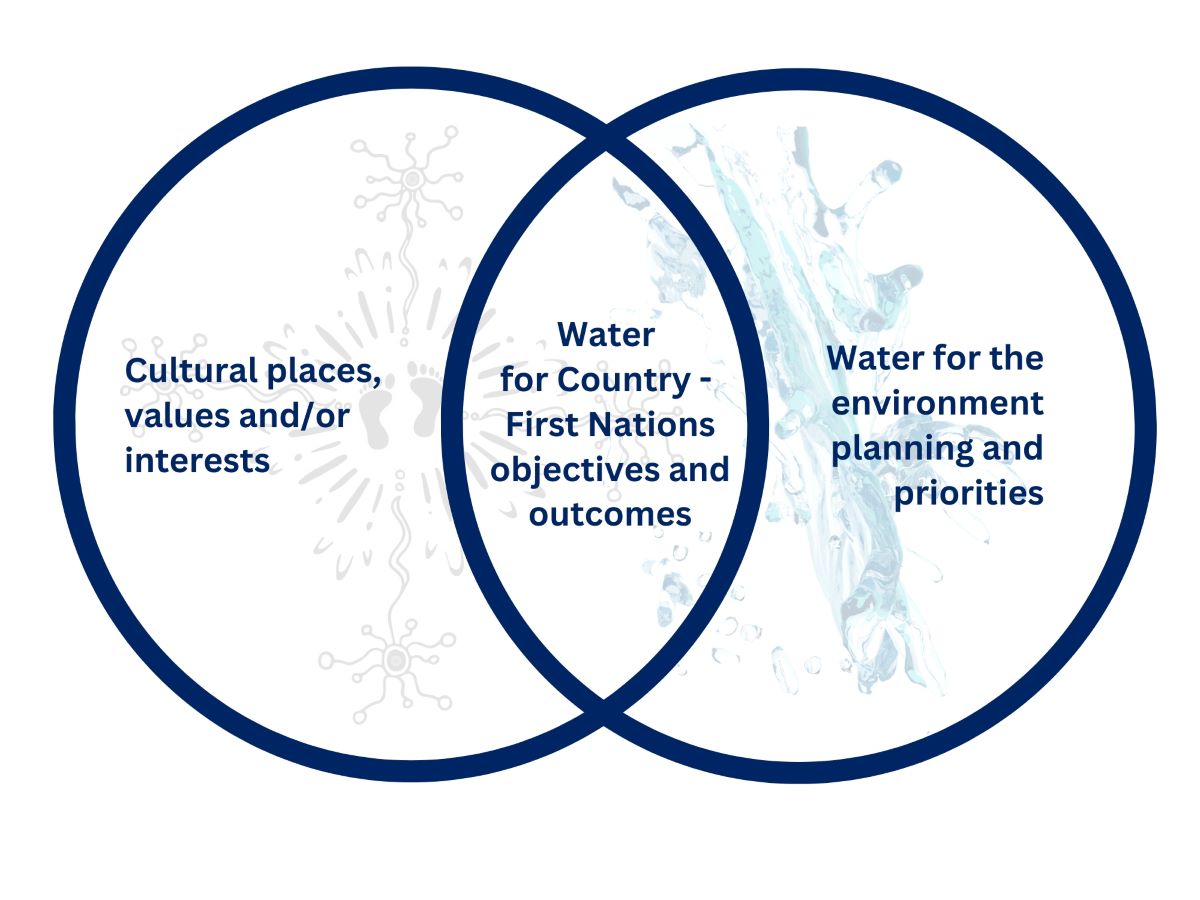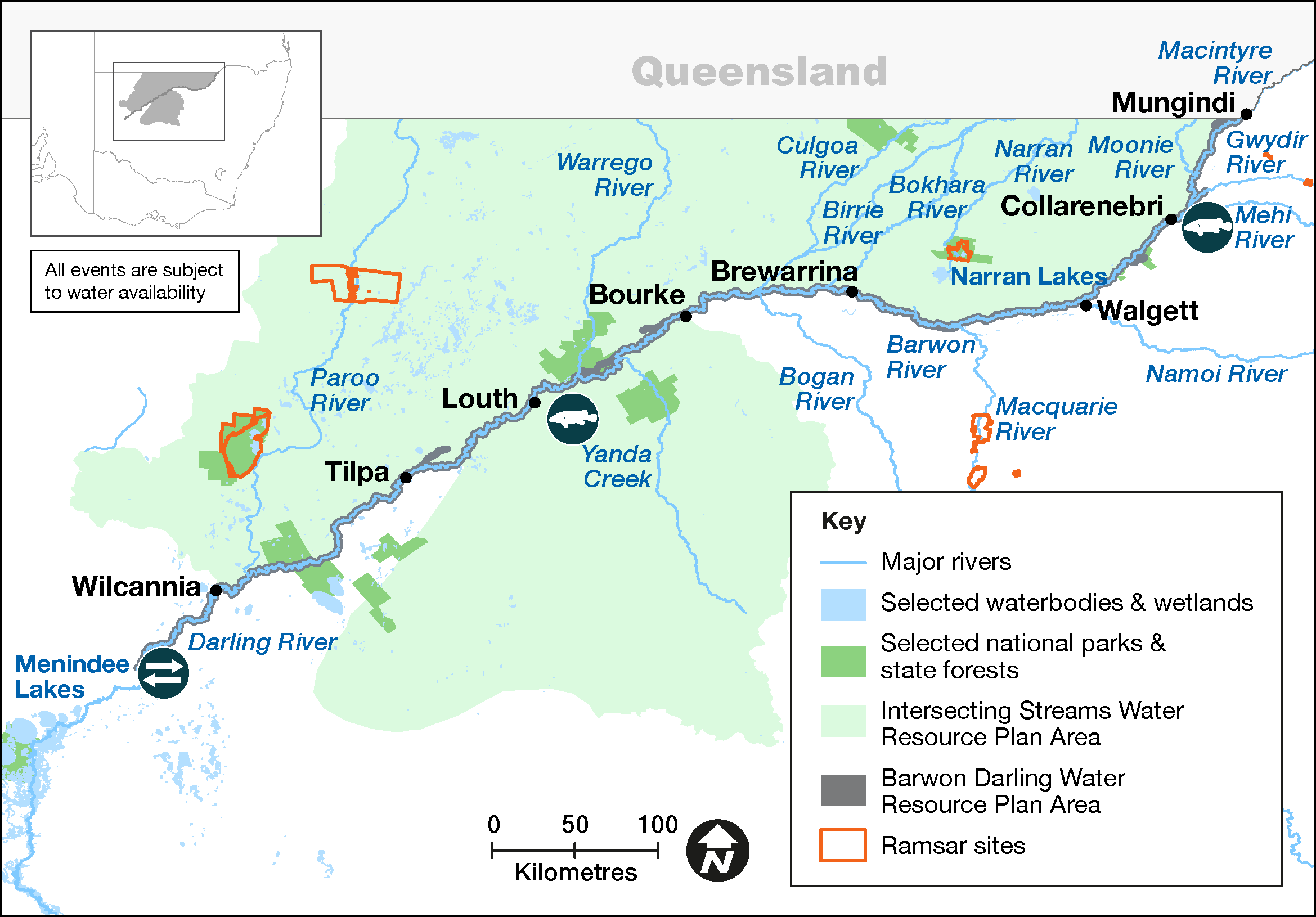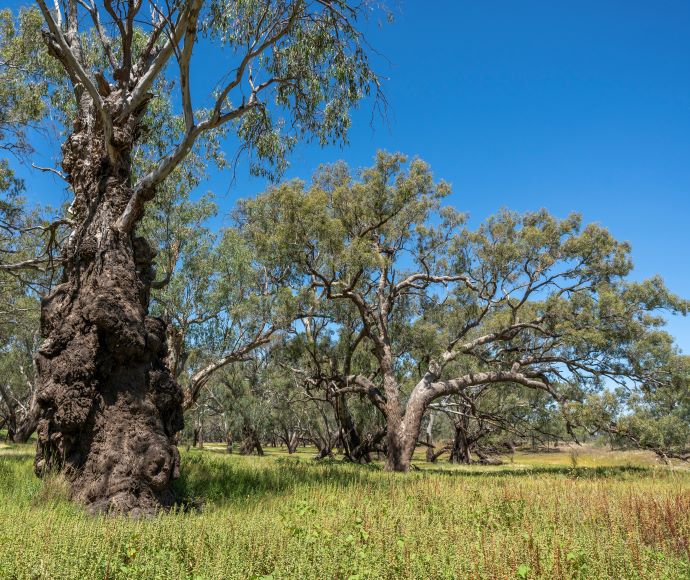Water that is allocated and managed specifically to improve the health of rivers, wetlands and floodplains is known as water for the environment.
NSW environmental water management teams work with local communities, Aboriginal representatives, partner agencies, and other stakeholders to develop detailed annual plans for the use of water for the environment in each catchment, including how its use is prioritised.
The catchment
The Barwon–Darling Barwaan–Culliwatta–Baaka connects the river systems of the northern Murray–Darling Basin with those of the south.
Several major river systems flow into the Barwon-Darling Barwaan–Culliwatta–Baaka including the Border, Moonie, Gwydir, Namoi, Macquarie Wambuul, Culgoa, Warrego and Paroo. The Barwon–Darling Barwaan–Culliwatta–Baaka rivers are the unregulated section of the river channel from the junction of the Macintyre and Weir rivers, near Mungindi, through to Lake Wetherell, part of the Menindee Lakes system. This includes distributary creeks and a myriad of floodplain wetlands, billabongs and streams.
The Barwon–Darling Barwaan–Culliwatta–Baaka rivers and wetlands support important cultural values for the Euahlayi, Barkindji, Murrawarri, Ngemba, Gomeroi/Kamilaroi and Ngiyampaa Aboriginal people.
Water for rivers and wetlands
The Barwon–Darling Barwaan–Culliwatta–Baaka rivers rely on rainfall and inflows from tributaries to support river health. Many of the tributaries which flow into the system are regulated by dams, weirs and floodplain structures. This influences the ability of water managers to actively plan events to enhance river and wetland outcomes in this system.
From summer 2020–21, the river has benefited from flows from both Queensland and NSW tributaries, with stable small fresh flows and multiple large fresh and overbank events up to December 2022. Significant rains along the Great Dividing Range replenished major headwater storages and led to several dam spills that increased tributary inflows to the system. Due to these conditions, water managers didn’t need to deliver environmental water in the Barwon–Darling Barwaan–Culliwatta–Baaka catchment in the 2022–23 water year.
Since December 2022, rainfall has decreased and river flows have started to recede. Localised rainfall and inflows from the eastern tributaries triggered some small events, but overall flows have been decreasing to base flows and to very low flows in some areas. This signals a possible return to dry conditions with potential cease to flow events.
Aboriginal water management priorities

Environmental water managers have been working to support Aboriginal people’s priorities in water management.
Water for Country is environmental water use planned by the Department of Climate Change, Energy, the Environment and Water and Aboriginal people to achieve shared benefits for the environment and cultural places, values and/ or interests.
In 2022–23, water managers worked closely with Aboriginal communities on the Murrawarri and Ngemba First Nations River Snails Survey Project and Dharriwaa Elders Tea Tree Mapping.
In 2023–24, water managers will continue to work with Murrawarri, Ngemba, Ngiyampaa, Euahlayi and Gomeroi Aboriginal people to identify and characterise priority environmental watering sites on the Barwaan–Culliwatta–Baaka including mapping of a culture corridor.
Weather and water forecast
As at early June the El Niño–Southern Oscillation (ENSO1) outlook is neutral, with a 50% chance that an El Niño may develop in late 2023. Rainfall was above average for July to November in eastern mainland Australia, including the Barwon–Darling Barwaan–Culliwatta–Baaka catchment. The wet conditions began to subside in December 2022 and in early 2023 have continued to become dryer.
Natural inflows are likely to stay low or decrease further in the Barwon–Darling Barwaan–Culliwatta–Baaka in the 2023–24 water year, reducing opportunities for water managers to use held licenses to protect flows in the Barwon–Darling Barwaan–Culliwatta–Baaka catchment. There is potential for widespread very low flow and cease to flow conditions to return.
Water managers have prepared annual watering plans that consider a range of weather and water availability scenarios. This is known as resource availability scenario planning. On balance, the outlook is rated as 'dry to moderate'.
1. ENSO: The interaction between the sea surface and atmosphere over the Pacific Ocean which results in dryer (El Nino) or wetter (La Nina) conditions.
Resource availability scenario
Current forecast: Dry to moderate
| Forecast | Main aim | Other aims |
|---|---|---|
| Very dry | Protect | Avoid critical loss Maintain key refuges Avoid catastrophic events |
| Dry | Maintain | Maintain river functioning Maintain key functions of high priority wetlands |
| Moderate | Recover | Improve ecological health and resilience Improve opportunities for plants and animals to breed, move and thrive |
| Wet to very wet | Enhance | Restore key floodplain and wetland linkages Enhance opportunities for plants and animals to breed, move and thrive |
Key planned actions for 2023–24
Native fish
As fish populations are still recovering from significant fish kills in the northern basin and at Menindee in early 2023, a key priority is to support remaining stocks of native fish and provide opportunities for them to breed and disperse along the system. A key goal is to maintain flows and support small fresh events to help supply food to native fish and other aquatic wildlife, including frogs.
Connectivity
Cease to flow conditions may return in 2023–24, with current drying conditions. Maintenance of low or base flows and provision of small freshes will be the primary focus of water managers. Under more moderate rainfall conditions, small freshes and more consistent base flows are more likely.
A high priority is maintenance of connecting flows between the Barwon–Darling Barwaan–Culliwatta–Baaka rivers and the Lower Darling Baaka, to support the recovery of native fish populations. However, river connectivity is impeded by lack of fish passage downstream of Menindee main weir. Maintaining connection along the length of the river will require wet or moderate conditions across the northern basin, which are forecast to be less likely under drying conditions.
Map of proposed annual priority targets in the water resource plan area 2023–24

Map of the Barwon-Darling catchment area showing priority targets for environmental water to be delivered to in 2023–24.
The department is supporting the health and resilience of rivers and wetlands by delivering water for the environment where and when it is needed. We use the best available science, management expertise and experience to manage water across the landscape. This statement of annual priorities identifies the waterways and wetlands that are likely to receive water.
Our decision-making process considers:
- expected availability of water in the coming year
- conditions of the previous year
- current health of the plants and animals in these ecosystems.
Water for the environment delivers benefits for communities, rivers, wetlands and wildlife across New South Wales.
Healthy, connected rivers and floodplains are a focus for tourism, fishing, recreation and relaxation. Rivers carry water to our homes, schools, farms and businesses, and along the way, support countless species including native fish, waterbirds, frogs, plants and more.
Rivers and wetlands have great cultural and spiritual significance for Aboriginal people.
Water for the environment is a critical tool to maintain and enhance the rivers, wetlands and wildlife we all love.
Working with communities
Local communities are at the heart of everything we do.
We involve the broader community by holding site tours and forums, and online and in-person events.
In catchments that have community-based environmental water advisory groups, NSW water management teams consult with them regularly.
Environmental water advisory group members include local landholders, recreational fishers, Aboriginal people and local government representatives. Their advice helps to inform the decisions made by our local environmental water management teams.
The Barwon–Darling Barwaan–Culliwatta–Baaka catchment doesn’t currently have an environmental water advisory groups, but the intention is to establish one soon.
Expected environmental water volumes available at 1 July 2023
The Department of Climate Change, Energy, the Environment and Water works with partner agencies to manage environmental water in the catchment.
Water licenced to the Commonwealth
| Source | Maximum volume available (megalitres) | Volume expected 1 July under current conditions (megalitres) |
|---|---|---|
| A class unregulated | 73 | Event-dependent |
| B class unregulated | 16,060 | Event-dependent |
| C class unregulated | 12,498 | Event-dependent |
Water licenced to New South Wales
| Source | Maximum volume available (megalitres) | Volume expected 1 July under current conditions (megalitres) |
|---|---|---|
| A class unregulated | 191 | Event-dependent |
| B class unregulated | 51 | Event-dependent |
| Unregulated | 1,488 | Event-dependent |
Notes: This is an indicative summary of expected volumes to be available. For further detail and information on available volumes you can contact the region via the Department of Climate Change, Energy, the Environment and Water on 1300 361 967.
1 gigalitre = 1000 megalitres; 2.5 megalitre = 1 Olympic swimming pool.
Water for the environment has been delivering outcomes for rivers, wetlands and wildlife for 30 years.
We deliver flows that:
- trigger native fish to breed and move
- support waterbirds to nest and feed
- connect rivers and floodplains
- water forests and floodplains
- allow plants to grow, flower and set seed
- create refuge during droughts
- enhance outcomes during wetter times
- release vital nutrients from the floodplain floor that underpin the aquatic food web.
It’s habitat restoration on a landscape scale.

The Barwon–Darling Barwaan–Culliwatta–Baaka connects the river systems of the northern Murray–Darling Basin with those of the south.
More information on planned and past watering events
- Annual environmental water priorities in the Barwon–Darling Barwaan-Baaka rivers 2022–23
- Barwon–Darling Rivers – Water for the Environment: Annual Priorities 2021–22
- Barwon-Darling rivers: Annual environmental watering priorities 2020–21
- Barwon Darling: Annual environmental watering priorities 2019–20
- Water for environment outcomes 2022–23
- Water for environment outcomes 2021–22
- Use of water for the environment in NSW: Outcomes 2020–21
- Use of water for the environment in NSW: Outcomes 2019–20
- Use of water for the environment in NSW: Outcomes 2018–19